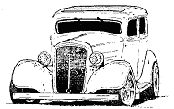
|

|

|

|

|

|

|

|

|

|

|

|

|

|

|

|

|

|

|

|

|

|

|
Jack Calori (11.03.22 - 24.11.2008)
JACK CALORI is probably most famous for his stunning ’36 Ford Coupe that appeared on the cover of Hot Rod Magazine. It was the first chopped ’36 3-window to use the 39 LaSalle grille and had ’40 Chevy headlights molded to the fenders. With its Buick teardrop skirts and 41’ Hudson tail lights Calori could not help but turn heads. He originally bought it to tow his ’29 hi-boy to the lakes. The 29 roadster, while holding a few records stood out from the crowd with its dual pipes coming up the side of the car past the doors (see pics).
As a young kid in 1939 Jack remembers his first run on the lakes: “…as I pull up to the line to go I looked over to my right at starting and there were three bodies covered with a sheet. Well, my legs were already shaking from my first experience. And it didn't help any. I went through and my best time that was which, uh, in those days I won 101 with, uh, 4-cylinder and that was a respectable speed.”
Jack Calori's 1936 Ford1936 Ford 3W Coupe built by Jack Calori and Herb Reneau. Jack bought the car from its original owner in 1947 to use as a tow car for his 1929 Ford Roadster.
Jack had the car stored in Herb's garage. Without any warning Herb cut the top off the car. Jack like the idea, and he and Herb continued to kustomize the car. To get the right stance, Jack stepped the rear of the frame, and installed a dropped axle at the front. Herb finished the top chop, and chopped the top 3 inches. Further they modified the car with a 1939 LaSalle grille, a clamshell hood, Buick teardrop skirts and molded 1940 Chevrolet headlights. The hood was lengthened three inces, and the side panels were louvered. The stock bumpers were replaced by bumpers from a 1941 Ford. At the rear the license plate was recessed in to the deck lid, and the car was modified with 1941 Hudson taillights. Herb did all the bodywork on Jacks coupe. The build was completed in 1948. Four inches clearance was obtained by dropping and filling the front axle, the rails over the rear axle were stepped.
Inside the upholstery, door panels and top were finished in dark red leatherette with ivory trim. Fittings were chromed. Unique feature of interior was a chrome tray which pulled out from right dash panel.
When Jack sold his 1929 Ford roadster, he kept the engine, a 59AB from a 1946 Mercury, and installed it in the coupe. The engine was bored and stroked 1/8 inch each way. It was equipped with a Clay Smith cam, a Lincoln distributor, Eddie Meyer heads, and a Weiand intake and Potvin ignition. The oil pan, dipstick tube, water pumps, generator case, and oil filler/breather were all chromed, and the heads and intake were polished. Jack tested the Coupe with the new engine in a Rusetta Timing Association run, and he clocked the car at 114.50 mph in 1948.
Jack traded the coupe in for a new 1950 Mercury in 1950. The car went from Lynwood to Minnesota. Several years later the car was found by Roger Domini in Washington. Roger owned the car for many years. In 2003, Jorge Zaragoza purchased the car and had Roy Brizio Street Rods restore it.
In 2005 the car won best in class in the first Early Custom Cars 1935-1948 class at Pebble Beach Concours d'Elegance. It also won the Dean Bachelor Award at the same show.
Today the car is displayed at the Peterson Automotive Museum.
Jack Calori, hot rodding and custom pioneer, dies at age 86
Unlike production cars, the history of hot rods and customs was rarely shaped by men in suits with official titles at big Detroit companies. Instead, the history of hot rods is told from the viewpoint of the garage-bound tinkerer, the individual, the grassroots idealist. Their stories aren’t told in corporate volumes or stock reports; instead, their stories are often hardly told, and their inspiring works largely uncredited.
Jack Calori was one of those tinkerer idealists and a founding father of both the hot rod movement and the custom movement at the same time. He never formed an aftermarket business to feed his hot rod appetite, never made a splash in the drag racing world and never dominated the show circuit, but he remained one of the more influential hot rodders, thanks largely to two cars: his skirted 1936 Ford three-window coupe, allegedly the first to use a 1939 LaSalle grille in its nose; and his Model A roadster, which he fit a flathead V-8 into and ran on both the streets and the dry lakes (at more than 120 MPH in the late 1940s) with a set of distinctive upswept chrome exhaust pipes on either side.
The former of the two cars, after a full restoration earlier this decade, took best in class for the Early Custom Cars class at the 2005 Pebble Beach Concours d’Elegance. The latter, long missing after Calori sold it to his dentist, has recently been cloned to remarkable precision.
Calori was able to see both the restored ’36 and the cloned Model A before he died on November 24 at age 86. - By Daniel Strohl
Magazine Features
- Hot Rod Magazine November 1949
- Trend Book 102 Hot Rods
- Rodders Journal Number 31



